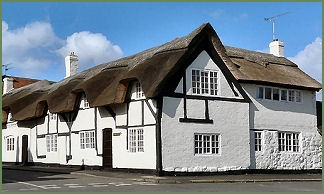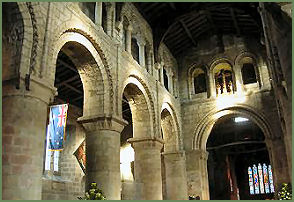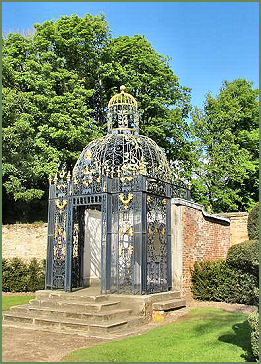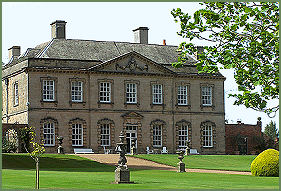Melbourne
OS Grid ref:- SK385255
 The Georgian market town of Melbourne is situated about 8 miles south of Derby.
The Georgian market town of Melbourne is situated about 8 miles south of Derby.
The name Melbourne means 'mill stream'. The town was was first recorded in the Domesday Book of 1086 as 'Mileburne' which means mill stream, it was then a royal manor.
Melbourne Castle was originally a royal manor house, from the time of the Saxon king Edward the Confessor until 1265 when King Henry III granted it to his second son Edmund, Earl of Lancaster. In 1311 Robert de Holand fortified the existing royal manor house to create a castle, though the fortification was never completed. In the mid to late fourteenth century, when owned of John of Gaunt, third son of Edward III, the curtain walled fortified manor possessed a drawbridge, a hall and great chamber, a chapel and a bakehouse. From the early fourteenth century the castle was primarily in the possession of the Earls and Dukes of Lancaster, Jean, duc de Bourbon, the most important French prisoner taken at the Battle of Agincourt in 1416, was held prisoner in the Melbourne Castle for 19 years.
 During the Wars of the Roses, it was partially dismantled by the Lancastrian forces of Margaret of Anjou. The tragic Mary, Queen of Scots was later imprisoned at Melbourne Castle, by her cousin Queen Elizabeth I, but it had deteriorated into a poor state of repair. By the early seventeenth century the castle was in a ruinous state and was being used as a pound for stray cattle and in 1604 it was sold to Sir Edward Howard and then to Henry Hastings, 5th Earl of Huntingdon who demolished the remaining structure in 1637, although some remains can still be seen today, a single wall stands behind Castle Farm, a partly seventeenth century brick house.
During the Wars of the Roses, it was partially dismantled by the Lancastrian forces of Margaret of Anjou. The tragic Mary, Queen of Scots was later imprisoned at Melbourne Castle, by her cousin Queen Elizabeth I, but it had deteriorated into a poor state of repair. By the early seventeenth century the castle was in a ruinous state and was being used as a pound for stray cattle and in 1604 it was sold to Sir Edward Howard and then to Henry Hastings, 5th Earl of Huntingdon who demolished the remaining structure in 1637, although some remains can still be seen today, a single wall stands behind Castle Farm, a partly seventeenth century brick house.
 Melbourne's Parish Church of St Micheal with St Mary, (pictured right) has been described as a 'cathedral in miniature' and is regarded as one of the finest Norman Parish Churches in the country. It was built about 1120, although a church is recorded on the site in the Domesday Book, Most of the original masonry is still intact, with the exception of the eastern end which has been refurbished. The roofs, naves, aisles and the aisle windows date from the restoration of the 1630s. A further restoration was carried out by Gilbert Scott in 1859-62. It contains alabaster slabs to Henry Hardie, who died in 1613, Anne Harding, who died in 1673 and Sir Robert Harding, who died in 1679.
Melbourne's Parish Church of St Micheal with St Mary, (pictured right) has been described as a 'cathedral in miniature' and is regarded as one of the finest Norman Parish Churches in the country. It was built about 1120, although a church is recorded on the site in the Domesday Book, Most of the original masonry is still intact, with the exception of the eastern end which has been refurbished. The roofs, naves, aisles and the aisle windows date from the restoration of the 1630s. A further restoration was carried out by Gilbert Scott in 1859-62. It contains alabaster slabs to Henry Hardie, who died in 1613, Anne Harding, who died in 1673 and Sir Robert Harding, who died in 1679.
 Melbourne Hall, (right) which stands adjacent to the church, was originally the rectory house for the Bishop of Carlisle, and dates from the seventeenth century, it became the home of Sir John Coke in 1628, but was substantially rebuilt by Thomas and George Coke in the early eighteenth century. the hall once belonged to William Lamb, Lord Melbourne, Queen Victoria`s first Prime Minister. The interior contains portraits by Sir Peter Lely and Cornelius Jansen and some fine period furniture.
Melbourne Hall, (right) which stands adjacent to the church, was originally the rectory house for the Bishop of Carlisle, and dates from the seventeenth century, it became the home of Sir John Coke in 1628, but was substantially rebuilt by Thomas and George Coke in the early eighteenth century. the hall once belonged to William Lamb, Lord Melbourne, Queen Victoria`s first Prime Minister. The interior contains portraits by Sir Peter Lely and Cornelius Jansen and some fine period furniture.
Melbourne Hall's extensive gardens were planned by Rt. Hon. Thomas Coke in the early part of the eighteenth century. They are designed with paths allowing easy access, and intersected by streams that flow through the grounds underneath miniature bridges and through the lush flower beds. They contain examples of the work of Derby ironsmith Robert Bakewell including an ornate, wrought iron arbour, known locally as the birdcage. (pictured left) Melbourne Pool was originally used by the nearby mill. The hall is open to the public in August.
The Thomas Cook Memorial Cottages stand in the High Street, they were built by Thomas Cook, one of the town's most famous sons, who started popular travel in England. Cook was born in Melbourne in 1808. The buildings were erected in 1890-91 and include fourteen cottages, a bakehouse, a laundry and mission hall.
Nearby places of interest
Tutbury Castle a largely ruinous medieval castle, which is owned by the Duchy of Lancaster and boasts an extraordinary history.
Dovedale, a dramatic limestone ravine, with its mpressive rock outcrops and tranquil woodlands is arguably the prettiest of the dales in the Peak District National Park and is owned by the National Trust.
The Manifold Valley, which runs almost parallel with Dovedale, has been described as the 'Switzerland of Staffordshire' and offers some of the most spectacular scenery in the Peak District National Park.
Biddulph Grange, one of Britain's most exciting and unusual gardens, was created by the horticulturalist James Bateman (1811–1897), for his large collection of plants from around the world.
Haddon Hall near Bakewell, is an architectural gem. Dating back to the eleventh century, the hall has been described as "the most complete and most interesting house of [its] period", it is the finest example of a medieval manor house currently in existence in England.
